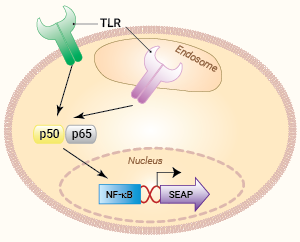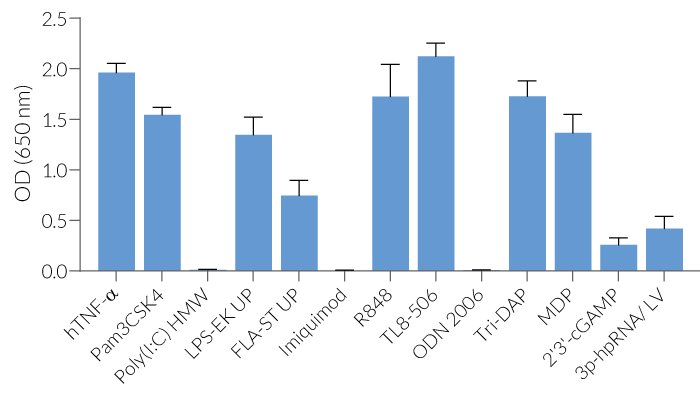THP1-Blue™ NF-κB Cells
| Product | Unit size | Cat. code | Docs. | Qty. | Price | |
|---|---|---|---|---|---|---|
|
THP1-Blue™ NF-κB Cells NF-κB-SEAP reporter monocytes |
Show product |
3-7 x 10e6 cells |
thp-nfkbv2
|
|
||
|
THP1-Blue™ NF-κB vial Additional cell vial |
Show product |
3-7 x 10e6 cells |
thp-nfkbv2-av
|
Notification: Reference #thp-nfkbv2-av can only be ordered together with reference #thp-nfkbv2.
NF-κB–SEAP Reporter Monocytes

Signaling pathways in THP1-Blue™ NF-κB cells
(click to enlarge)
THP1-Blue™ NF-κB cells were specifically designed for monitoring the NF-κB signal transduction pathway in a physiologically relevant cell line. THP1-Blue™ cells were derived from the human THP-1 monocyte cell line by stable integration of an NF-κB-inducible SEAP reporter construct.
As a result, THP1-Blue™ NF-κB cells allow the monitoring of NF-κB activation by assessing the activity of SEAP (secreted embryonic alkaline phosphatase). The level of NF-κB-induced SEAP in the cell culture supernatant is readily assessed with QUANTI-Blue™, a SEAP detection reagent.
THP-1 cells endogenously express many pattern-recognition receptors (PRRs), including Toll-like receptors (TLRs), the stimulator of interferon genes (STING), and RIG-I-like receptors (RLR). Therefore, THP1-Blue™ NF-κB cells are highly responsive to PRR agonists that trigger the NF-κB pathway (see figure).
Key features
- Functionally validated with a selection of PRR ligands and cytokines
- Readily assessable NF-κB activation by assessing the SEAP activity
Note: A new clone is provided with an improved reporter/background signal ratio. The cat code has been changed accordingly (thp-nfkbv2).
Back to the topSpecifications
Antibiotic resistance: Zeocin®
Growth medium: RPMI 1640, 2 mM L-glutamine, 25 mM HEPES, 10% heat-inactivated fetal bovine serum, 100 μg/ml Normocin™, Pen-Strep (100 U/ml-100 μg/ml)
Quality Control:
- Reporter activity has been verified by functional assays.
- The stability for 20 passages, following thawing, has been verified.
- These cells are guaranteed mycoplasma-free.
Please note, that the old clone purchased before March 2024 (cat. code thp-nfkb) is selectable with Blasticidin. For more details, please read the technical data sheet.
Back to the topContents
- 1 vial of THP1-Blue™ NF-κB cells (3-7 x 106 cells) in freezing medium
- 1 ml of Normocin™ (50 mg/ml)
- 1 ml of Zeocin® (100 mg/ml)
- 1 ml of QB reagent and 1 ml of QB buffer (sufficient to prepare 100 ml of QUANTI-Blue™ Solution, a SEAP detection reagent)
-
 Shipped on dry ice (Europe, USA, Canada and some areas in Asia)
Shipped on dry ice (Europe, USA, Canada and some areas in Asia)






